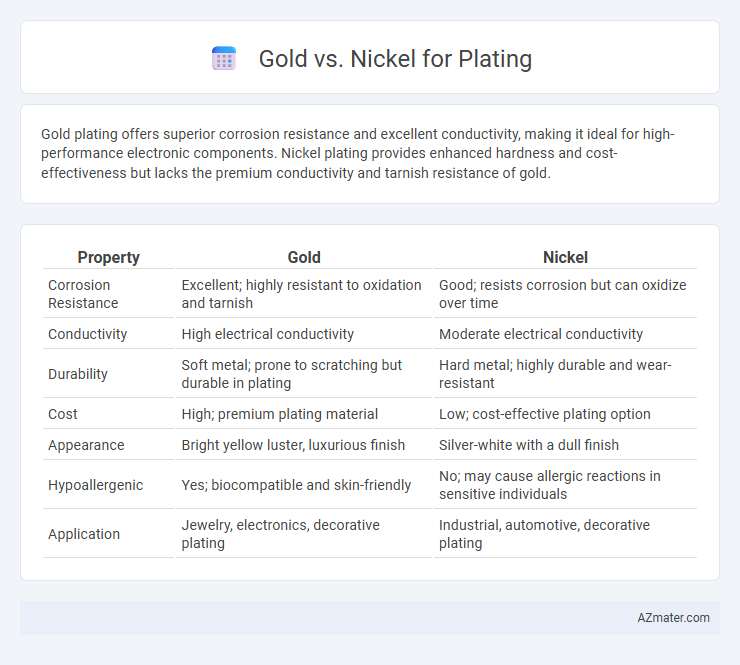Gold plating offers superior corrosion resistance and excellent conductivity, making it ideal for high-performance electronic components. Nickel plating provides enhanced hardness and cost-effectiveness but lacks the premium conductivity and tarnish resistance of gold.
Table of Comparison
| Property | Gold | Nickel |
|---|---|---|
| Corrosion Resistance | Excellent; highly resistant to oxidation and tarnish | Good; resists corrosion but can oxidize over time |
| Conductivity | High electrical conductivity | Moderate electrical conductivity |
| Durability | Soft metal; prone to scratching but durable in plating | Hard metal; highly durable and wear-resistant |
| Cost | High; premium plating material | Low; cost-effective plating option |
| Appearance | Bright yellow luster, luxurious finish | Silver-white with a dull finish |
| Hypoallergenic | Yes; biocompatible and skin-friendly | No; may cause allergic reactions in sensitive individuals |
| Application | Jewelry, electronics, decorative plating | Industrial, automotive, decorative plating |
Introduction to Metal Plating: Gold vs Nickel
Gold plating provides superior corrosion resistance and excellent electrical conductivity, making it ideal for high-performance electronics and decorative applications. Nickel plating offers robust hardness and wear resistance, commonly used for industrial components requiring durability and cost-effectiveness. The choice between gold and nickel plating depends on application requirements such as conductivity, aesthetics, and environmental exposure.
Key Differences Between Gold and Nickel Plating
Gold plating offers superior corrosion resistance and excellent electrical conductivity, making it ideal for high-performance electronics and decorative finishes. Nickel plating provides robust wear resistance and hardness, often used for industrial applications requiring durability and cost-effectiveness. While gold plating resists tarnish and oxidation, nickel plating can develop a protective oxide layer that enhances its mechanical properties.
Electrical Conductivity: Gold vs Nickel
Gold offers superior electrical conductivity compared to nickel, with a conductivity of approximately 44.2 MS/m versus nickel's 14.3 MS/m. This higher conductivity makes gold plating ideal for electronic connectors and contacts where minimal resistance and signal loss are critical. Nickel plating provides durability and corrosion resistance but compromises electrical performance relative to gold.
Corrosion Resistance and Durability
Gold offers superior corrosion resistance due to its inertness, preventing oxidation and tarnishing even in harsh environments. Nickel plating provides exceptional durability and hardness, making it ideal for wear-resistant applications but may be prone to corrosion if exposed to moisture or acids without protective coatings. Choosing between gold and nickel plating depends on the balance between the need for high corrosion resistance with a premium finish versus mechanical strength and cost-effectiveness.
Cost Comparison: Gold Plating vs Nickel Plating
Gold plating is significantly more expensive than nickel plating due to the high market price of gold and the complex deposition process required. Nickel plating offers a cost-effective alternative, providing good corrosion resistance and durability at a fraction of gold's price. For applications where budget constraints are critical, nickel plating is often preferred despite gold's superior aesthetic and conductive properties.
Applications in Electronics and Industry
Gold exhibits superior corrosion resistance and excellent electrical conductivity, making it ideal for high-reliability electronic connectors, circuit boards, and semiconductor components. Nickel plating offers robust mechanical strength and wear resistance, commonly used in industrial applications such as automotive parts, machinery, and electronic contacts where durability is critical. Both metals provide essential protective coatings, but gold is preferred in precision electronics due to its non-oxidizing properties, while nickel is favored for cost-effective, heavy-duty industrial uses.
Aesthetic Appeal and Surface Finish
Gold plating offers a rich, lustrous appearance with excellent resistance to tarnishing, making it ideal for high-end decorative applications and jewelry where aesthetic appeal is paramount. Nickel plating provides a bright, smooth finish with superior hardness and corrosion resistance, commonly used for industrial parts and appliances requiring durability and a polished look. The choice between gold and nickel plating depends on whether the priority is luxury and visual warmth or a robust, shiny, and cost-effective surface finish.
Environmental Impact of Gold and Nickel Plating
Gold plating involves the use of cyanide-based chemicals and generates toxic waste, posing significant environmental hazards during extraction and processing. Nickel plating releases heavy metals and hazardous byproducts, contributing to water pollution and requiring stringent waste management to minimize ecological damage. Both metals demand careful handling and advanced recycling techniques to reduce their environmental footprint in plating applications.
Maintenance and Longevity
Gold plating offers superior corrosion resistance and requires minimal maintenance, maintaining its luster and conductivity over extended periods. Nickel plating provides robust hardness and wear resistance but tends to develop oxidation and discoloration, necessitating more frequent cleaning and upkeep. The longevity of gold plating is generally higher due to its inert nature, making it suitable for environments demanding consistent performance with low maintenance.
Choosing the Right Plating: Factors to Consider
Choosing the right plating between gold and nickel depends on factors like corrosion resistance, conductivity, and aesthetic appeal. Gold plating offers superior corrosion resistance and excellent conductivity, making it ideal for electronic contacts, while nickel provides a durable, cost-effective option with higher hardness and wear resistance. Evaluating environmental conditions, budget constraints, and functional requirements ensures optimal plating selection for enhanced performance and longevity.

Infographic: Gold vs Nickel for Plating
 azmater.com
azmater.com